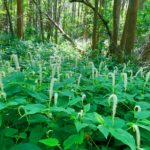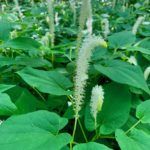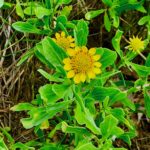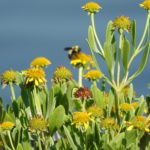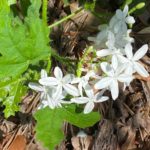By Mary Reid Barrow
Lizard’s tail
Walk on the bridge at First Landing State Park across from the parking lot at the 64th Street entrance.
Take a whiff. You’ll a get faint scent of sassafras.
And then you’ll see the swamp is awash with tiny white blooms on long spikes that grow from plants with heart-shaped leaves.
The flowers are reminiscent of a lizard’s tail the way they curve at the end and that’s its common name. Its scientific name, Saururus cernuus, comes from the Latin for lizard and tail.
You can’t mistake lizard’s tail for any other plant in marshes and swamps around this part of Virginia. It grows along the edges and in shallow water too.
Seaside oxeye daisy
Almost a daisy but not quite, pretty seaside oxeye daisy grows in sandy areas long the salt marsh at First Landing State Park.
Its yellow petals surround a large , darker yellow-orange center with noticeable black anthers. The dark anthers, which are the part of a flower that produces pollen, give this daisy a distinctive look.
Oxeye daisies, in general, get their common name from their large ox-eye like centers.
Some call it the silver sea oxeye because its fleshy slightly hairy foliage has a silver tinge.
Bumblebees, butterflies and other insects nectar on the oxeye daisy. Because of its long blooming time, its flower is a source of food for insects for a good part of the year. Terri Gorman caught this bumblebee nectaring on sea oxeye daisies in the park.
Horse nettle
You will find horse nettle grow in sandy soil at the edge of the woods along the park trail. Its white star-shaped blooms are like bright lights in the forest among the green shrubs and ferns.
The pretty white blooms lure you in, but its prickly stems quickly say, don’t mess with me. And if you do, you may get an itchy rash from the prickles. Horse nettle is sometimes call stinging nettle for just this reason.
Interestingly later in the year horse nettle bears what looks like little green cocktail tomatoes that turn yellow. But don’t let them fool you either. More off-putting than the prickles, horse nettle fruit is poisonous!
Horse nettle got its name, because it is often found growing around horse pastures and it has been known to poison livestock that munch on it.
Close-up, horse nettle is not a very pleasant plant, come to think of it, but it sure is pleasant from afar as it brightens up the trail edges this time of year.
Do you have a favorite tree or plant with a story to tell? What relationships have you observed between plants and critters? Who eats whom? Who has babies where? Send an email to maryreid@lrnow.org
B
